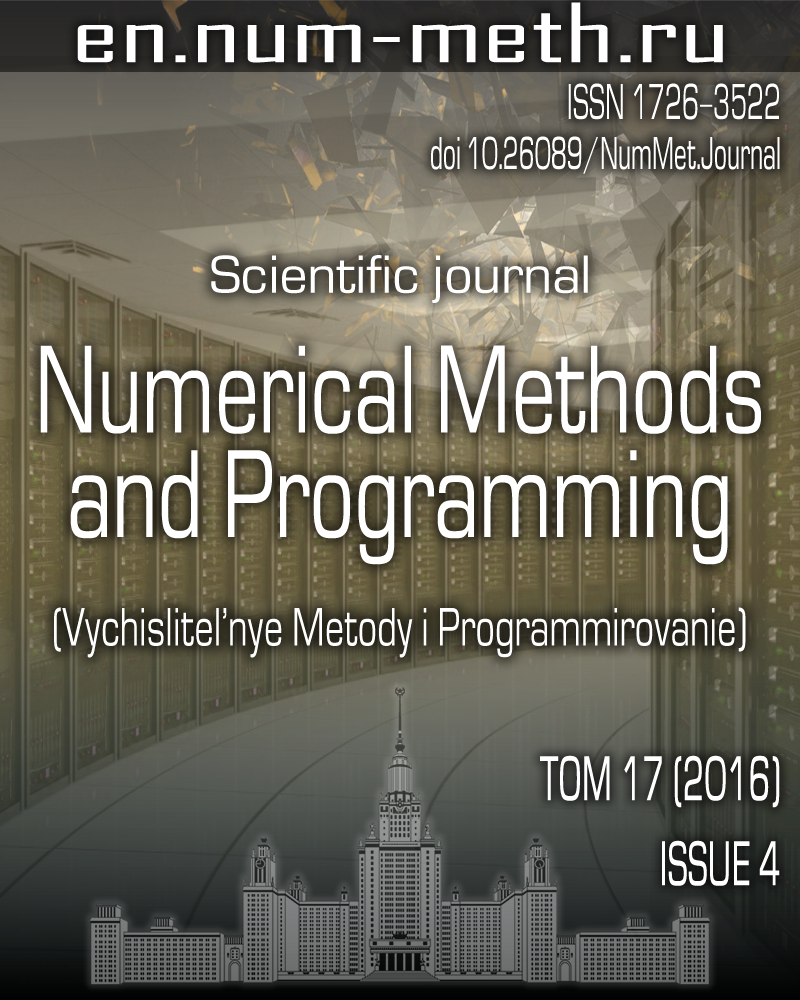Fluctuations of the turbulent diffusion coefficient in galaxy dynamo equations
DOI:
https://doi.org/10.26089/NumMet.v17r441Keywords:
galaxy magnetic fields, equations with random coefficients, intermittency, dynamo theoryAbstract
When studying magnetic fields in galaxies with inhomogeneous media, it is reasonable to study dynamo equations with random coefficients. These equations are useful to describe magnetic fields in galaxies with intensive star formation, supernova explosions and other active processes that change the properties of interstellar media. Before we studied the equations where the alpha-effect coefficient is random. In this paper we study the problem where the turbulent diffusion coefficient has fluctuations. We propose a model where the coefficient takes one of two values with some probabilities on small time intervals and after that renews. We obtain estimates for the asymptotic rates of growth. These estimates are confirmed and improved by numerical simulation procedures. It is shown that for some probabilities the growth of the magnetic field is changed by decay. It is also shown that the intermittency phenomenon takes place in such equations: the higher momenta of the magnetic field grow faster than the lower ones. The magnetic field behavior is studied in the nonlinear case, which corresponds to the appearance of inhomogeneity in the interstellar medium after the instant when the magnetic field has reached the stationary state.
References
- Ya. B. Zel’dovich, S. A. Molchanov, A. A. Ruzmaikin, and D. D. Sokolov, “Intermittency in Random Media,” Usp. Fiz. Nauk 152 (1), 3-32 (1987) [Sov. Phys. Usp. 30 (5), 353-369 (1987)].
- D. A. Grachev, “A Relation between Numerical and Analytical Results for Stochastic Differential Equations ,” Vychisl. Metody Programm. 9, 234-238 (2008).
- Ya. B. Zel’dovich, “Observations in a Universe Homogeneous in the Mean,” Astron. Zh. 41 (1), 19-24 (1964) [Sov. Astron. 8 (1), 13-16 (1964)].
- E. A. Mikhailov, D. D. Sokoloff, and V. N. Tutubalin, “The Fundamental Matrix for the Jacobi Equation with Random Coefficients,” Vychisl. Metody Programm. 11, 261-268 (2010).
- V. N. Tutubalin, “A Central Limit Theorem for Products of Random Matrices and Some of Its Applications,” Symposia Mathematica XXI}, 101-116 (1977).
- R. Beck, A. Brandenburg, D. Moss, et al., “Galactic Magnetism: Recent Development and Perspectives,” Ann. Rev. Astron. Astrophys. 34, 155-206 (1996).
- T. G. Arshakian, R. Beck, M. Krause, and D. Sokoloff, “Evolution of Magnetic Fields in Galaxies and Future Observational Tests with the Square Kilometre Array,” Astron. Astrophys. 494 (1), 21-32 (2009).
- E. A. Mikhailov, “Star Formation and Galactic Dynamo Model with Helicity Fluxes,” Pis’ma Astron. Zh. 40 (7), 445-453 (2014) [Astron. Lett. 40 (7), 398-405 (2014)].
- E. A. Mikhailov and I. I. Modyaev, “Galactic Dynamo Equations with Random Coefficients,” Vychisl. Metody Programm. 15, 351-358 (2014).
- M. R. E. Proctor, “Effects on Fluctuations on αΩ Dynamo Models,” Mon. Not. R. Astron. Soc. 382 (1), L39-L42 (2007).
- K. J. Richardson and M. R. E. Proctor, “Fluctuating αΩ Dynamos by Iterated Matrices,” Mon. Not. R. Astron. Soc. 422 (1), L53-L56 (2012).
- A. P. L. Newton and E. Kim, “Determining the Temporal Dynamics of the Solar α Effect.’’ Astron. Astrophys. 551 (2013).
doi 10.1051/0004-6361/201219456 - D. Passos, D. Nandy, S. Hazra, and I. Lopes, “A Solar Dynamo Model Driven by Mean-Field Alpha and Babcock-Leighton Sources: Fluctuations, Grand-Minima-Maxima, and Hemispheric Asymmetry in Sunspot Cycles,” Astron. Astrophys. 563 (2014).
doi 10.1051/0004-6361/201322635 - S. Sur and K. Subramanian, “Galactic Dynamo Action in Presence of Stochastic α and Shear,” Mon. Not. R. Astron. Soc. 392 (1), L6-L10 (2009).
- H. K. Moffatt, Magnetic Field Generation in Electrically Conducting Fluids (Cambridge Univ. Press, Cambridge, 1978; Mir, Moscow, 1980).
- D. Moss, “On the Generation of Bisymmetric Magnetic Field Structures in Spiral Galaxies by Tidal Interactions,” Mon. Not. R. Astron. Soc. 275 (1), 191-194 (1995).
- A. Phillips, “A Comparison of the Asymptotic and no-z Approximations for Galactic Dynamos,” Geophys. Astrophys. Fluid Dyn. 94, Nos. 1-2, 135-150 (2001).
- E. A. Illarionov, D. D. Sokoloff, and V. N. Tutubalin, “Stationary Distribution of Product of Matrices with Random Coefficients,” Vychisl. Metody Programm. 13, 218-225 (2012).
- E. A. Mikhailov and I. I. Modyaev, “Dynamo Equations with Random Coefficients,” Magnetohydrodynamics 51 (2), 285-292 (2015).

